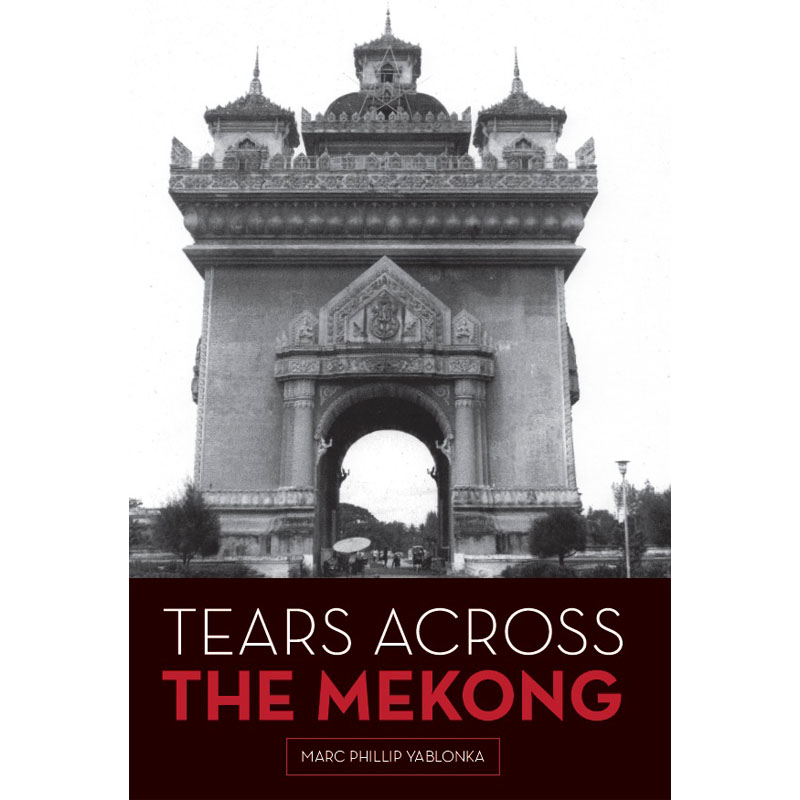Tears Across the Mekong

Our Books
Tears Across the Mekong
Marc Yablonka$25.00
Marc Yablonka’s book Tears Across the Mekong is an excellent work. Laos and its integral involvement in the Vietnam war remain unknown by most. The book dispels the fog of ignorance, revealing experiences and thoughts from a host of sources, both American- and Laotian-born. The myth of communist beneficence is exposed by first-hand accounts of post-war suffering in Laos. Tears Across the Mekong is of value to both professional historians and those without in-depth knowledge of Laos and North Vietnam’s invasion of that country. Very informative. Get it. Read it. Learn from it. –Bill Laurie, U.S. Army Intelligence, Military Assistance Command Vietnam – 1971-`7, Defense Attaché’s Office – 1973 – `75, Co-Author, Whitwash/Blackwash: Myths of the Viet Nam War, Mesa, Arizona
In his latest work, Tears Across the Mekong, military author and journalist Marc Yablonka has once again set the bar for authenticity and historical perspective in his latest anthology on the Vietnam era in Southeast Asia.
As related to us by a well thought-out collection of personal interviews with participants who lived through these events, a vivid and compelling story emerges that takes the reader back nearly a half century to describe what it was like to be part of what is now referred to as the ‘Secret War in Laos’.
While the Vietnam war and its aftermath have been thoroughly documented in fact and fiction, Tears Across the Mekong offers insights on that war-torn era’s impact on the Laotian populace, particularly in its effects on the sturdy and fiercely-loyal Hmong mountain tribesmen, who took up arms on behalf of the U.S. to combat the brutal hardships wrought by the Communist regime that seized control of their historically peaceful nation.
For anyone truly interested in learning more about this tragic period, Marc has delivered a real page-turner that will hold you spellbound as you read the real-life accounts of those who were intimately involved with or victimized by that little-known conflict. –COL W. R. Johnson (U.S. Army, Ret.), 11th Armored Cavalry Regiment Vietnam – 1970, Army General Staff – Pentagon – 1982 – `85, Joint Chiefs of Staff – Pentagon – 1988 – `91, Asia-Pacific specialist, Chiang Mai, Thailand
To purchase, please call: (800) 934-9313
Author Biography
Reviews (3)
3 reviews for Tears Across the Mekong
You must be logged in to post a review.



Allen Cates –
The history of the war in Laos is complicated, conflicted and often incorrect. Marc Yablonka did it differently. He allowed those who were there to tell their side of the story with a collection of anecdotal interviews. Laos described as a sleepy kingdom located in the middle of Southeast Asia, was unknown by most westerners. The war in French Indochina and eventually Vietnam brought to the forefront the perceived importance of this landlocked monarchy. The question remained whether the means, the devastation and spent blood and treasure, were worth the eventual result. The king and queen who were neutral were arrested and died of malnutrition in a primitive camp in northern Laos. The Pathet Lao lost every battle and won the war, and Laos became a communist country. The Hmong, who supported the Americans bravely and valiantly, were left dangling in an ill wind. The finger pointing continues, but America did not attack Laos or wage war against the Royal Lao government. Often described as the CIA secret war, Laos was America’s secret war and in the early sixties, they were faced with a dilemma. America signed the 1962 Geneva Accords altruistically and departed with due diligence. But, North Vietnam didn’t act accordingly and used neutral Laos to transport soldiers and war materials into South Vietnam to kill Americans supporting the South Vietnamese government. America continued responsibly and conducted photo recon flights to prove North Vietnam’s violation. They responded by shooting down the recon aircraft. The solution was to react overtly and violate the Geneva Accords and incur the wrath of public opinion, walk away and leave the Pacific Rim in jeopardy, or attempt to stop them clandestinely. They chose the latter and placed a government owned airline called Air America into a military situation they were not prepared to handle. The administration described them as mercenaries to hide their true identity. Almost two hundred killed in action, and when the war was over, they were sent home with no benefits and no recognition hoping they would just fade away. America did not handle Air America correctly, but who is to blame for the travesty, death and misery in Laos? Only America brought thousands of Hmong and Lao refugees to America and allowed them to become doctors, attorneys and businesspeople with freedom to worship as they pleased and to prosper. North Vietnam did not and weren’t they too to blame? Who started the war in Southeast Asia? It wasn’t America. Who placed loyal Hmong, Lao, and Vietnamese in concentration camps where many perished? It wasn’t America. Those who criticize Americans who fought for freedom in Southeast Asia do it in America, where they have the freedom of speech. They don’t do it in Laos or North Vietnam. Why not? Every person who wants to know the truth about the war in Laos should read Marc’s book Tears Across The Mekong.
Allen Cates
Author
Honor-Denied; The Truth About Air America And The CIA
Raymond C. Morris –
In the early ’70s I was the CO of a small select group of Green Berets stationed at a camp in Northern Thailand working for the CIA to train Hmong Commandos, and insert them back into Laos to conduct raids and ambushes on convoys headed south to Vietnam. A few years earlier I had trained and led Montagnards in Vietnam’s Central Highlands. I found the Hmong and “Yard” tribesmen to be not much different in nature. They proved to be great warriors, demonstrating amazing bravery once trained, with loyalty both to us and their fellow tribesmen. They also possessed a remarkable sense of good humor despite lives of extreme abuse and hardships. Marc Phillip Yablonka lays it out chapter and verse better than anyone I have read on the subject. From a historical viewpoint it’s well researched and methodical, extremely interesting, and yes, for me at least, still a little heartbreaking. I recall with great sadness the Hmong’s warm humor and optimism, and how they looked upon us as saviors from a life of oppression. Or, maybe it was only because we treated them with respect, and as human beings. If you want to peek into the lives of people who have lived with strife and war, Yablonka captures it all. Unlike the high visibility of some parts of the world, this history will soon be lost without work such as Tears Across the Mekong. Yablonka’s book should be mandatory reading for all high school students prior to graduation.
Raymond C. Morris
Author
The Either Zone
Tender Prey
Don’t Make the Blackbirds Cry
Henry Zeybel –
In 1983, former Green Beret Jim Morris (four Bronze Stars and four Purple Hearts) wrote a book called War Story. In it he wrote about fighting alongside Montagnards in the Central Highlands of Vietnam. Morris convincingly made the point that the “Yards” were fighters unto themselves and never received the recognition they deserved.
In Tears Across the Mekong, Marc Phillip Yablonka does an excellent job claiming that the same holds true for Hmong warriors from the highlands of Laos. Yablonka tells the Hmong story through interviews with those who escaped from Laos after the Pathet Lao communists took control of the nation in 1975.
A large majority of the interviewees were soldiers who fought for the CIA and the Royal Lao Government against the Pathet Lao and North Vietnamese Army during the so-called secret war in Laos. The men fought primarily in Northern Laos, but they also worked along the Ho Chi Minh Trail, conducted raids into North Vietnam, and in at least one instance engaged Chinese infantrymen. Other interviewees had been schoolteachers and administrators—intellectuals the communists did not trust.
Hmong soldiers normally entered the army in their late teens and many fought for a decade or more. Hmong KIA numbered between 25,000 and 35,000. Misled by a false promise to build a free and democratic nation, 100,000 Hmong chose not to leave the country following the war’s end. They ended up in Pathet Lao re-education “seminars” that, for some, lasted more than ten years.
Life in the prison-like seminars consisted of hard labor and indoctrination lectures amid inadequate living conditions and occasional torture. Those who fell sick were allowed to die of “natural causes.” Little wonder that imprisoned Hmong fled at the first opportunity.
Escaping from the seminars and evading pirates when crossing the Mekong River into Thailand was merely half of the journey to freedom. Living conditions were only slightly better in Thailand where government officials stole from refugees, abused them verbally, and herded them into camps with minimal accommodations. Some Hmong spent years getting visas and resettlement agreements. All of the people interviewed by Yablonka reached the United States.
For students of the evolution of governments in what once was French Indochina, Yablonka’s interviews show that the communist tactics in Laos were comparable to those in Vietnam, but far less severe than those of the Cambodian Killing Fields.
Nevertheless, Hmong people who have found freedom still worry about relatives and friends remaining in Laos. They believe that the CIA and the U.S. government have forgotten their contribution to the war. Few have returned to Laos or want to do so. Yablonka echoes Hmong sentiments about the war and calls for worldwide programs to help them.
Interviews with two Air America helicopter pilots—Dick Casterlin and Allen Cates—provide histories of their unit’s organization and background of the secret war. The brief histories are valuable reading because, as Yablonka reminds us, Laos was the “most under-reported and least visited” theater of the Vietnam War era. The two pilots emphasize that Air America worked for the government and not the Central Intelligence Agency, one of its “customers.” Both men flew in Laos during the 1960s. Their favorite memories are of search-and-rescue missions.
Yablonka is a journalist whose articles have appeared in many military magazines. He served for eight years in the California State Military Reserve, a support brigade of the California National Guard and the U.S. Army Reserves, and did two tours with the Israeli Defense Force.
Tears Across the Mekong evolved from his master’s thesis.
A reminder: Read Jim Morris’ War Story. It’s an honest-to-goodness prizewinner—and it complements Yablonka’s perspective on Southeast Asian tribal warriors.
—Henry Zeybel, Lt. Col., USAF (Retired)
From: The VVA Veteran, Books in Review II